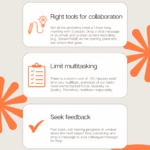
Have you ever felt hesitant to speak up in virtual meetings? You are itching to share your idea, but for some reason, you cannot put words in your mouth to speak up. You are worried whether you might come across as incompetent or lacking communication skills. Or to put it simply, you might feel like all eyes are pointing straight at you, even behind the screen, and therefore can feel quite intimidating. We have all been there at least once and there is nothing to worry about.
When you don’t speak up and add value, not only is it bad for your profile, it’s also depriving the group of your thoughts. But don’t beat yourself up about it because this is something even senior executives face.
May bush, Founder of Career Mastery™1
As with many other challenges faced by professionals working remotely or even in an office setup, this can be remedied with the right mindset and approach. The key thing to remember is that everyone’s situation/ root cause for why they feel hesitant to speak up in a virtual meeting is unique and personal. For example, things such as fear of sounding unprepared or wrong, lack of nonverbal cues, intimidation by hierarchy or overthinking can prevent someone from speaking up. However, there is no need to beat yourself up over this matter. Below, I am laying out some strategies to overcome this challenge and I am certain you will find them useful.
Understand Why
First of all, it is important you pause a moment to understand why you feel hesitant to speak up in virtual meetings. Is it because you are worried that you might come across as incompetent in a particular subject or whether you are concerned about your communication/language skills? Or is it because of a lack of non-verbal cues when seeing the audience through the screen? The deeper you dive into your own thoughts, the more closer you get to finding the right solution to your struggle. Stop worrying about what others might think of you, no one is perfect.
Worst Case Scenario
This is a major finding you will discover when you get to the bottom of understanding why you feel hesitant to speak up in virtual meetings. The more you know the reason why you are hesitant, the more insightful you become in foreseeing the worst-case scenario. The more you understand the worst-case scenario, the more prepared you can become to handle the situation. For example, if you are concerned about lacking knowledge in a certain topic, you can polish your knowledge ahead of the meeting.
Prepare Ahead of Time
Before the meeting, take time to review the agenda. After reviewing the agenda you can anticipate where you might be able to add value. You can jot down your thoughts or questions related to the topics being discussed. Having some notes to refer to will certainly help you to jump into a discussion.
Use Chat, then Talk
If you do not feel comfortable sharing your thoughts verbally at first, you can always drop a message in the chat and wait for the host to address your message. Then as a follow-up or an addition, you can straight jump into the discussion. In that way, you avoid the initial attention-grabbing phase and make straight inroads to the middle of the discussion where you can contribute.
Signal Your Intent to Speak
Modern chat applications come with options to show your intent to speak. For example, if you are using Microsoft Teams2, you can use the raise hands option (✋) to show your intent to speak. This will notify the host and the audience about your intention to speak. I personally think this is a smart and non-disruptive way to jump into a discussion especially when there are over ten or so participants in the meeting.
Experiment with a Limited Audience
If you are someone who is hesitant to speak up when the number of participants is high, you can always try this in a meeting with a limited audience or with 1:1 meetings. For example, you can use meetings with your manager or colleagues to build up a conversation and improve your communication skills actively. Meetings with a limited audience will certainly help to boost your confidence and eventually, you will feel no different when talking in meeting with a large group of participants.
Attend Early & Leverage Small Wins
You can attend meetings five to ten minutes early and start speaking up before all the participants have turned up, even just to say “Good morning”, ask about someone’s weekend, or agree with someone if they have already having a casual chit-chat before the actual meeting begins. These small, early contributions help you to break the ice and reduce anxiety when speaking later when everyone has joined the meeting.
Practice Assertive Communication
Assertive communication is being able to convey your thoughts, intentions, and needs directly and respectfully while also respecting others’ rights and needs3. You can start conversations using phrases such as “Can I just add something here“, “I would like to offer a different perspective.“, “Adding on top of what you have already mentioned, how about we do…..” and so on. Practising assertive communication helps you to boost your confidence, achieve your goals and improve your self-esteem.
Seek Feedback
Asking your colleague, line manager or an attendee about how they found your contributions (e.g., a question you asked, or an idea you shared) in a meeting is a great way to assess your participation. You can go one step deeper and find whether they liked the way how you communicated and whether was it easy to follow. Any feedback you receive should be directed towards improving your hesitancy in speaking up in virtual meetings, not to be taken personally.
In a Nutshell
It is perfectly normal to feel hesitant when speaking up in virtual meetings. We have all been there at least once in our lifetime. This is very similar to how we feel when walk onto a stage in front of a massive audience. To address this problem, first, we need to sit down and understand why we feel hesitant. The more you build up a conversation with yourself asking why, the closer you will get to understanding why you feel hesitant when speaking up in virtual meetings. Once you know the root of the problem, finding the correct solution shouldn’t be difficult. Throughout this article, we discussed various strategies to overcome the challenge of feeling hesitant when speaking up in virtual meetings.
🎯 Need Expert Help?
If you’re facing challenges with remote work, I offer 1:1 coaching and tailored support to help you succeed at remote setup. Whether you’re just starting out, growing as a remote contributor, leading a team, or launching a remote-first start-up, Remote Winners offers targeted 1:1 coaching to help you thrive in a distributed world. We also provide tech consultancy services—from idea-to-product guidance to cloud deployment and cybersecurity reviews—to help organisations strengthen their technology and processes.
If you are unsure where to begin, drop us a message and we’ll be in touch.



